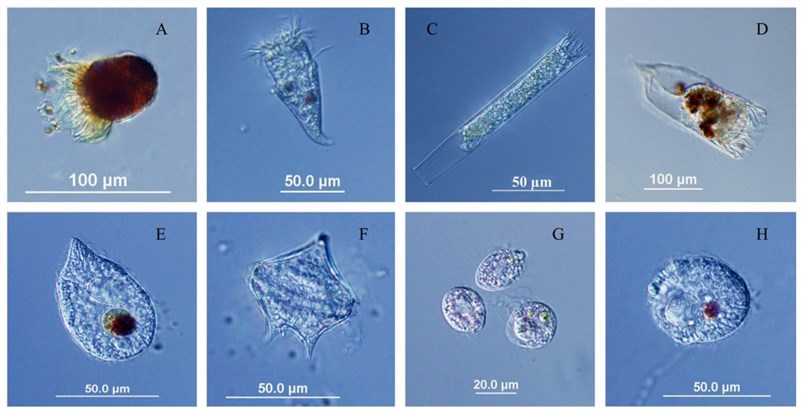Overview of Protozoa
These organisms are a collection of microbes that usually feed on organic debris. They come in many different shapes ranging from Amoeba which can change shape to Paramecium which has a fixed shape. They vary in size, ranging from a few micrometers to tens of millimeters, or larger. They exist in almost all possible habitats all over the world. In most cases, they exist in freshwater, marine environments and soil. Additionally, some species have been found to thrive in extreme circumstances, such as hot springs and highly saline lakes. In theory, a moist habitat is necessary for protozoa. However, some protozoa form cysts in dry conditions, enabling them to remain dormant until external conditions improve.
 Fig.1 Protozoa. (Frank Fox, etc) Distributed under CC BY-SA 4.0, from Wiki, without modification.
Fig.1 Protozoa. (Frank Fox, etc) Distributed under CC BY-SA 4.0, from Wiki, without modification.
Structure of Protozoa
Like other eukaryotes, the nuclei of protozoa are membrane-encased. In most protozoa, the nuclei are vacuolated and dispersed chromatin makes the nuclei diffuse. It is noteworthy that the plasma membrane that encloses the cytoplasm also covers many prominent motor structures, such as pseudopodia and flagella. Furthermore, the organelles of protozoa have many functions that are equivalent to the organs of higher animals. For example, certain protozoa, such as trypanosomes, have an outer surface layer called a membrane, which is rigid enough to maintain a distinctive shape. However, these organisms are prone to bending as they move through their environment. Currently, as technology advances, electron microscopy is emerging as a promising tool for visualizing details of protozoan structures.
Reproduction
Parasitic protozoa have different modes of multiplying, either sexual or asexual. Binary, the most typical form of amplification, is asexual. Many protozoa might exchange genetic material sexually, but this is usually decoupled from the reproductive process and has no immediate impact on population numbers. It's worth noting that sexual reproduction is rare and usually occurs when the surroundings alter dramatically or food is scarce.
Life Cycle Stages
From the perspective of the whole life cycle, protozoa have two stages, the trophozoite and the cyst. They transition between two phases. When they convert to trophozoites, they are in a feeding and replicating phase. Many protozoa, when exposed to harsh circumstances, such as harmful substances or nutrient deprivation, become cysts, a dehydrated, protective form of the organism. Cysts allow the organism to survive in various situations, thereby making the spread of the organism easier. Protozoa are typically found in diverse organisms, including animals as well as plants. Although most of them are free-living, all higher animals experience more than one infection during their life. The range of infection is very wide, ranging from mild to life-threatening, which is mainly closely related to the type of protozoa and the resistance of the host.
Antibodies (Abs) at Creative Biolabs
As an expert in the field of Abs, Creative Biolabs is committed to providing rigorously tested Ab products to customers around the world. Based on our strict control of quality, our Ab products have become the first choice of many research institutions and pharmaceutical companies. A wide variety of protozoa-related Ab products are available or customized. If you are interested in our anti-protozoa Abs, please feel free to contact us.
More Ab product information is available through the link below:
-
-
AibGenesis™ Anti-A. castellanii cysts Monoclonal Antibody (Mouse mAb) (CAT#: MAS-0124-YJ6)
- Host: Mouse
- Reactivity: A. castellanii
- Applications: FC; IHC
- Conjugations: Conjugation could be customized
-
-
-
AibGenesis™ Anti-A. castellanii Monoclonal Antibody (Mouse mAb) (CAT#: MAS-0124-YJ5)
- Host: Mouse
- Reactivity: A. castellanii
- Applications: FC; IHC
- Conjugations: Conjugation could be customized
-
For Research Use Only. Do NOT use in humans or animals.